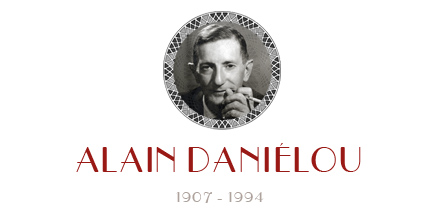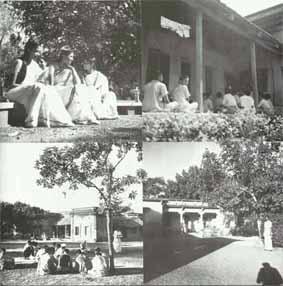Edito
Intersecting Itineraries: Tagore and Daniélou.
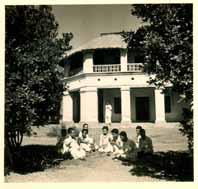 In 2011, celebrations worldwide are commemorating the one-hundred-and-fiftieth anniversary of the birth of the Nobel Prize for literature, Rabindranath Tagore, the poet whose aim was to reconcile East and West. For eighty years, Alain Daniélou’s work has provided insights into the life of this singular individual, with whom he had much in common, a fact that may explain their somewhat unexpected though lasting friendship.
In 2011, celebrations worldwide are commemorating the one-hundred-and-fiftieth anniversary of the birth of the Nobel Prize for literature, Rabindranath Tagore, the poet whose aim was to reconcile East and West. For eighty years, Alain Daniélou’s work has provided insights into the life of this singular individual, with whom he had much in common, a fact that may explain their somewhat unexpected though lasting friendship.
On June 18, 2011, in the presence of Bangladeshi and Indian authorities, the Embassy of France in Dhaka, together with the Dhaka Alliance française, organised the official opening of the exhibition of photographs taken by Alain Daniélou and Raymond Burnier entitled Tagore and the Universal Message. The exhibition was set up by the Alliance française at Chittagong where it opened on May 3-4, in the presence of the Foreign Secretary of
Bangladesh and Ms Bibi Russell, the special envoy of Unesco. Presented with the collaboration of the Alain Daniélou Centre for Studies/ Harsharan Foundation and the Alain Daniélou India Committee, the exhibition enjoys the moral support of UNESCO as part of the programme Reconciled Universal, commemorating Rabindranath Tagore, Pablo Neruda, and Aimé Césaire. The event was enthusiastically applauded by the international press, a success owing to the attraction of Tagore’s work and importance of the Daniélou archives. Photographs, paintings, music, translations, narratives and testimonies: the archive’s material is uniquely valuable for a rediscovery of one of the key players in the cultural history of the twentieth century. This exhibition also provides an opportunity for re-examining the numerous traits shared by Tagore and Daniélou.
In many respects, Tagore embodies what is known as the Bengali
Renaissance while, on his side, Daniélou, having explored traditional wisdom, went on to rediscover the sources of the European Renaissance. Their work is an appeal to cultivate the art of living and freedom of thought, and well as the reuniting of knowledge and the arts. This message is found in the set of photos portraying teachers and pupils among the age-old trees, or while they decorate the walls of their library with frescoes. The smiling faces of these boys and girls reflect their joyful willingness to learn, in partnership
with their environment, their source of inspiration.
In 1901, Tagore chose rural Santiniketan to set up a centre of education. In 1932, when Daniélou and Burnier first stayed there, one of the most original pages in contemporary cultural history was being written. A series of return trips made the two companions familiar with this initiative inspired and directed by the poet. Daniélou took an interest in Tagore’s song-poems and started his musicological research on Indian music. It was also the beginning of his discovery of rural India. With Burnier, he took several sets of photographs, devoted to Tagore’s school, Santal dances and country fairs. They also arranged for Christine Bossennec to come and direct the girls’ section. Christine later played a key role in Franco-Indian cultural relations.
About fifteen years later, when India had won its independence, the poet’s son Rathindranath asked Daniélou to orchestrate the Indian national anthem, the song that had been set to music by his father, who also wrote the words of Jana Gana Mana.v In 1961, at the Musée Guimet in Paris, at the celebration for the centenary of the poet’s birth, Daniélou was invited to speak publicly of his collaboration with Tagore and, that same year, published three of the latter’s song-poems. The poet deemed that broadcasting his songs beyond the subcontinent was of the highest importance. Toward the end of his life, Daniélou devoted himself to publishing his own orchestration and translation of fifteen other poems.vi
Daniélou shared with Tagore the qualities of a free-thinker and a prolific and versatile artist and, like the poet, played a vital role in promoting the intangible heritage of mankind. Both men acquired their skills outside any formal frameworkvii and took care not to become mired in any of the numerous ideologies. They chose to lead an “offset” existence, far from the centres of power that had seen their development and proffered their hands. Calcutta was the second city in the greatest empire of that time when, in 1901, Tagore left to go to Santiniketan, in the Bengal countryside. In the early ’30s, when he seemed set for a career in Paris, Daniélou, dancer and musician, set his hand instead to a lifetime of travel.
Among the Bauls, the Santal communities, sharing in the rural life of Bengal, with its six seasons and numerous village festivals, Tagore found the right atmosphere for creative work. He encouraged the scholars around him to gather oral traditions, including Baul and Kabir songs.viii One century later, traditional Baul songs were declared to belong to the world’s intangible heritage, while Kabir songs are still popular in the Indian music industry.
On leaving Paris, Daniélou was about to discover refined and living musical traditions. Following the semantics of each of these traditions, he set himself to demonstrate their universal value and introduced them to the whole world through his recordings and publications. Thus one of UNESCO’s pioneering productions promoting our intangible heritage was realised, the fruit of research begun at Santiniketan. Today, Daniélou’s promotion of musical traditions has provided work for thousands of musicians.
This set of photos shows Tagore animated by an amused smile. “Be serious about your work, without taking yourself seriously”, as he liked to advise the author and script writer René Goscinny. This principle illustrates perfectly the outlook of the two friends, both of whom produced a considerable corpus of work without ever relinquishing a solid sense of humour. One of the interesting things about their work is their effective ability to put forward contradictory points of view that reflect reality, humour being a means of doing so with elegance.
Daniélou described Tagore as being curious about everything, about the whole world, on the look-out for the slightest sign of life, of creation. This description is close to Nicolas Nabokov’s description of the musicologist himself. That immense curiosity and ability to put truths too easily accepted into perspective allowed them to penetrate beyond appearances and never cease their search.
We know the result: for Tagore, an immense repertory of poems and songs, as well as essays, choreographies, plays and about two thousand paintings, beside the setting up and direction of his educational establishments; for Daniélou, about forty books (studies, translations, novels), over four hundred articles, tens of thousands of memoranda on Indian culture, hundreds of hours of music recordings gathered in various parts of the world, thousands of photographs, several musical compositions and choreographies, and hundreds of paintings, together with the organisation of concerts and debates devoted to music… forming an immense archive, multimedial before the term had been coined. These works by self-educated persons, among the most outstanding of their time, remain as reference points for the cultural and artistic history of the twentieth century and a source of inspiration for the twenty-first.
1 India has a national anthem, Jana Gana Mana, entirely composed by Tagore, and a national song, Vande Mataram, the words of which were written by Bankim Chandra Chattopadhyay and the music by Tagore. Rabindranath Tagore, The National Anthem [of India]. (Jana-Gana-Mana.) Melody and Words by Rabindranath Tagore. (Visva Bharathi authorised version.) Transcription and piano arrangement by Shiva Sharan (Alain Danielou), Office of the High Commission of India, c. 1950.
1 Rabindranath Tagore, Poèmes chantés/Song-poems, présentés, traduits et adaptés par Alain Daniélou, Michel de Maule, 2005.
1 Neither of them obtained a degree.
1 As in the case of Ksitish Mohan Sen, Amartya Sen’s maternal grandfather, portrayed in one of the photos exhibited.
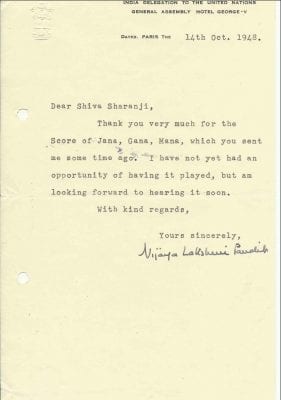
TAGORE the Universel message :
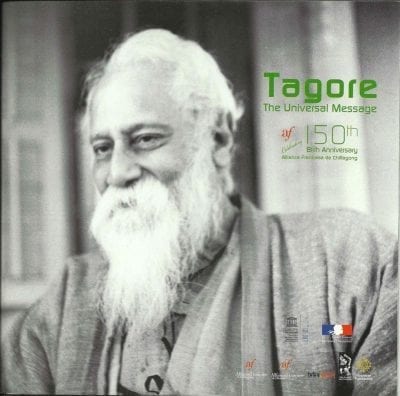
For the 150th birth anniversary of Universal Poet Rabindranath Tagore Alliance française de Chittagong is proposing an exceptional one year long program.
The program will be inaugurated on the 3rd of May with Mr Md Mirajul Quayes, Foreign Secretary, Government of the People’s Republic of Bangladesh. Shila Momen will deliver a recital of Tagore’s songs.
On the 4th by H.E. Charley Causeret, Ambassador of France in Dhaka, and Bibi Russell, Special Envoy of Unesco will open to the public an exceptional exhibition of unpublished pictures of Tagore and Santiniketan (1932-1940) by photographers Raymond Burnier and Alain Daniélou. This program is organised by Alliance française de Chittagong, in collaboration with the French Embassy in Dhaka, the Alain Daniélou India Committee, the Alliance française de Dhaka and the moral support of Unesco.
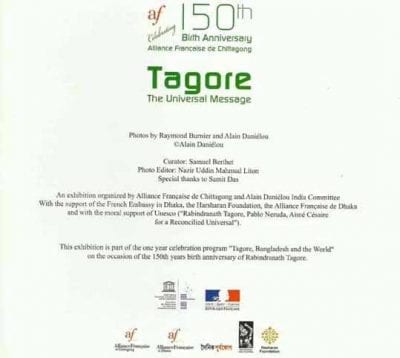
Links of all articles
http://www.thenews.com.pk/TodaysPrintDetail.aspx?ID=45901&Cat=1&dt=5/9/2011
http://gasiantimes.com/lifestyle/rediscovered-photos-show-tagore-in-new-light/
http://www.dawn.com/2011/05/09/rediscovered-photos-show-tagore-in-new-light.html
While the gods play:
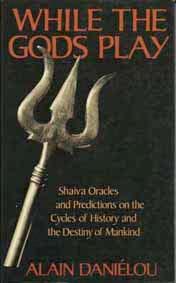 According to the early writings of the Shaiva tradition – still alive in India and dating back at least 6,000 years – the arbitrary ideologies and moralistic religions of modern society signal the last days of humanity heading toward destruction.
According to the early writings of the Shaiva tradition – still alive in India and dating back at least 6,000 years – the arbitrary ideologies and moralistic religions of modern society signal the last days of humanity heading toward destruction.
This predilection is only a fragment of the vast knowledge of Shaivism, the religion of the ancient Dravidians. An initiate of the Shaiva wisdom, author Alain Daniélou has assimilated and revived essential concepts of the Shaiva philosophy and its predilections. Clearly expressed in the ancient teaching, these concepts are in accord with, yet surpass, the boldest scientific speculations about consciousness, time, the nature of life and matter, and the history and destiny of the human race. Inherent in this body of knowledge is an understanding of the cycles of creation and destruction which, in conjunction with astronomical phases, determine the life span of the species. Since 1939, humankind has been in the twilight of the Kali Yuga age, or at the end of a cycle. The impending cataclysm, Daniélou explains, is brought on by our own errors, and its date will be determined by our present and future actions. While the Gods Play examines how the visionaries of ancient times defined our role in creation. It explains why and how we have abandoned this role, and reflects on what action can be taken to consciously and creatively influence our own destiny. Included are chapters on The Religion of Nature and The Religion of the City, The Transmigrant Body, Sexual Rites, the Castes, Sacrifice, Magical Powers, monastic Orders, and Forestalling the Final Day.
One of the most distinguished living orientalists and a friend of Stravinsky, Jean Cocteau and Nabokov, Daniélou spent more than 20 years in India studying music and philosophy. He wrote the acclaimed Gods of India and Shiva and Dionysus and produced a series of ethnic music recording for UNESCO. Formely director of the International Institute for Comparative Music Studies in Berlin and Venice, he is a Chevalier de la Légion d’Honneur, Chevalier des Arts et des Lettres, and Officier du Mérite National.
Saturday, May 7, a long article in India’s Tribune on Danielou’s transcription project for Tagore’s Songs. The article is based on an interview given by Francesca Cassio at Chandighar.
The Tribune India :
Saturday, May 7, 2011
Notes of harmony
Gurudev wanted his music to be heard beyond the boundaries of Bengal. He invited French artist and scholar Alain Dani`E9lou to Santiniketan in 1932 to transcribe Rabindra Sangeet for the western audience, writes Vandana Shukla.
Link : http://www.tribuneindia.com/2011/20110507/saturday/main4.htm
Albums
Copies of this album can be purchased on our site www.alaindanielou.org under the heading “Boutique”. If not delivered within 20 days, our contacts are e-mail info@alaindanielou.org, Fax +33 (0) 9 55 48 33 60, Vocal message: +33 (0) 9 50 48 33 60
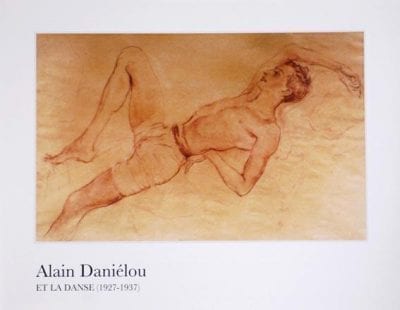
Alain Daniélou and Dance (1927-1937)
With a view to preserving these old photos and revealing a little-known side of Alain Daniélou – his career as a dancer in the ’thirties -, the Alain Daniélou Study Centre has produced this album, which brings to life part of his artistic life prior to his departure for India, where he would dance for the poet Rabindranath Tagore.
Once settled in Benares in 1937, he abandoned dance to study Indian music, learning to play the Vina, before devoting himself to Hindu tradition, culture and philosophy.
In 1994, his friend, the composer Sylvano Bussotti took an interest in the music composed by Alain Daniélou in his youth, and published a small collection “Quatre danses d’Alain”, which he completed. These dances have been performed by the artist Toni Candeloro, and by others.
Alain Daniélou Study Centre, April 2011
